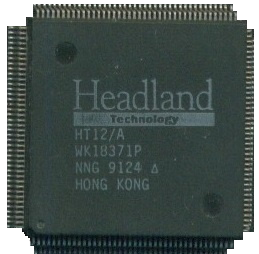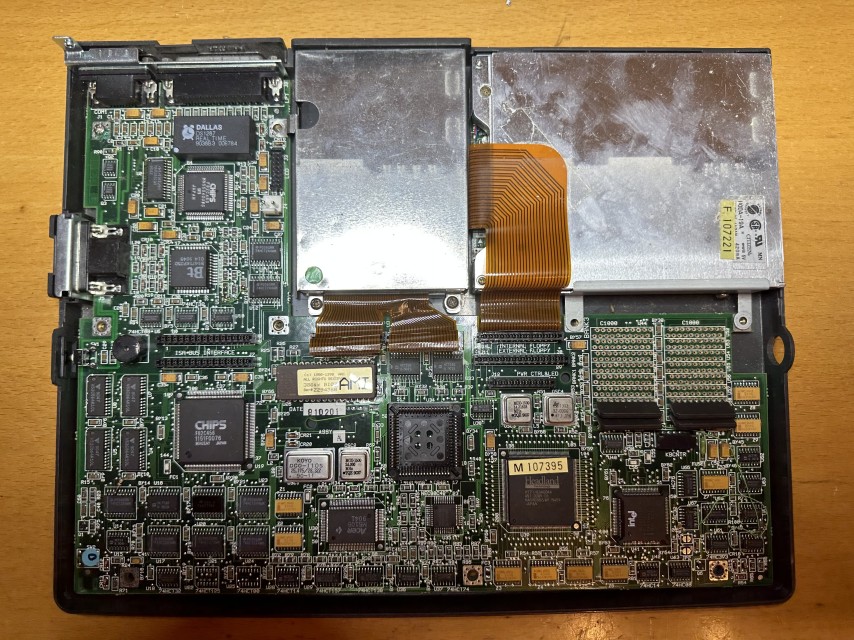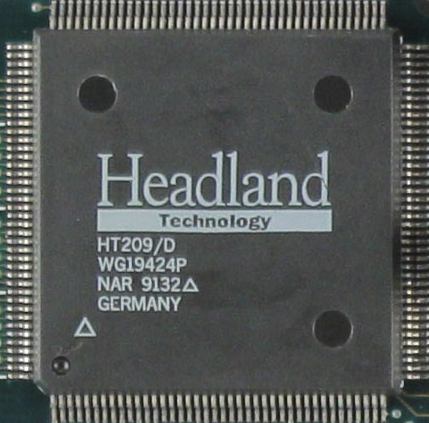 Headland Technology, Inc.
Headland Technology, Inc.
Headland Technology were a motherboard and graphics chipset manufacturer for PC compatibles during the 80286 era. They were direct rivals of the likes of Chips & Technologies, VLSI, Texas Instruments and Suntac in the early PC chipset market.
In 1989, they merged with G2, a rival chipset manufacturer, but continued to sell G2's products as the "G2 Product Line" such as the GC101 and GC102 chips which are the same as the Headland HT101/HT102 chips. This trend continued through to 1990, covering all their chipsets up to and including the GC208/HT208 SVGA chipset.
"Video Seven and G-2 agreed last week to merge, forming Headland Technology Inc.
Headland will be an affiliate of LSI Logic Corp. and will serve the laptop and desktop computer markets by providing system and graphics technology at the chip and board level to OEMs and resellers.
William O'Meara, former president of G-2, will become CEO
and vice president of sales and marketing, while Video Seven president Paul Jain will become president of Headland.
The company will provide graphics and logic products for PCs. 'Our focus is going to be very, very strongly on continuing to enhance the VGA product line we have,' Jain said. 'We are looking at an effort that will drive color LCD screens in the laptop market.'
Product development plans include VGA products with static RAMs, RISC chip sets, and Unix and 8514A products.
In related news, Video Seven said it will be the first board maker to support the Video Electronic Standards Association BIOS interface for Super VGA." - Patricia J. Pane, Info World, 10 April 1989
Headland were bought by LSI Logic a few years later, who produced VESA Local Bus graphics controller chips.
Motherboard Chipsets
  HT101/102 (also branded as GC101/102) HT101/102 (also branded as GC101/102)
An 80286 chipset released in February 1988.
It supports 80286 CPUs of 12 MHz and 16 MHz.
Datasheet |
 GCK113 GCK113
An 80386 chipset released in March 1989.
Datasheet |
 GCK181 GCK181
A universal PS/2 chipset released in October 1989.
Datasheet
|
 HT11 HT11
A rare single-chip 286 chipset, released in August 1990.
|
 HT12/12A HT12/12A
Launched in August 1990, HT12 was a popular 286 chipset used on many later, more tightly integrated 286 motherboards. It is able to support faster 80286 CPUs up to 20 MHz (not sure about the Harris 25 MHz) as well as hardware EMS (Expanded Memory Specification) support with special HT12 chipset drivers.
There are two drivers - one supports UMB (Upper Memory Blocks), the other adds EMS via the HT12 chipset. You can download the EMS one here. Unfortunately, the UMB one is elusive across the interwebs - let me know if you come across it.
I have written an article that focuses on getting both UMBs and EMS/XMS working with this chipset here.
Known to be used on the following systems and motherboards:
- Commodore 286/16
- Octek Fox II
- GW-286
- Advantech Industrial PC PCA-6126 (286 CPU card w/ ROM disk)
- LM103S
- Eurosoft HT12
- BI-025C
- Schneider EuroPC 286 (note: this PC's proprietary BIOS has no hardware EMS support)
|
.jpg) HT18 HT18
A 386SX single-chip chipset launched in September 1991.
Thanks to Vicente Esteve for providing images of his 386SX laptop (see below) which is based on the Headland HT18 chipset. The make and model of the laptop is unknown, so if you can identify it, please get in touch!
.jpg) .jpg) .jpg)
|
 HT21 HT21
A 286 and 386SX chipset launched in August 1991. For 286-class motherboards, the HT21 supports up to 20 MHz CPUs.
Thanks to Peter Schmidl for the HT21 shot and more pics here from his HT21-based 386SX-16 laptop (see below) - a Walkom NP-903, which is the same as the MicroStar NoteStar NP-903 - these have a Chips & Technologies 82C456 VGA controller.
MicroStar also sold the NoteStar NP-902 which was a 286-12 and used a C&T chipset with an embedded Cirrus Logic Stingray VGA.
 
|
 HT22 HT22
A 286 and 386SX chipset launched in September 1991. For 286-class motherboards, the HT22 supports the Harris 80C286-25 MHz CPU.
It is likely the HT22 was a mildly upgraded HT21 that was able to cope with 25 MHz CPUs over the HT21's 20 MHz.
|
 HT25 HT25
A 386SX [up to 25 MHz] single-chip chipset, supporting CPUs from 2.7V up to 3.6V. This means it also supports the AMD Am386SXLV and Cyrix Cx486SLC CPUs.
|
 HTK320 HTK320
A two-chip 80386DX chipset suitable for motherboards up to 40 MHz, launched in September 1991. It consisted of the following:
HT321 - ISA Bus Controller
HT322 - Memory Control Unit (MCU)
Datasheet
|
 HTK340 HTK340
Codenamed "Shasta", this was a 486 chipset launched in June 1992.
|
Graphics Card Chipsets
 GC201 GC201
An EGA chipset released in 1987. A company called Gemini were responsible for the development of the chipset.
The GC201 integrated three core components that make up an EGA card:
- Graphics controller
- Sequencer
- Attribute controller
This meant that a graphics card manufacturer need only provide a small number of additional components, such as a BIOS and memory chips, in order to bring a card to market quickly.
Datasheet |
  GC205 / HT205 GC205 / HT205
A VGA chipset released in 1988, sometimes referred to as the V7VGA Super VGA chip, after its use on their Video Seven VGA card. The chip itself can access up the 1 MB of video memory and can support either DRAM or VRAM. It was succeeded by the HT208 and HT209 processors which added 1024 x 768 resolution, up to 1 MB of linear addressing, colour expansion, and a hardware cursor.
The V7VGA is equipped with the Super VGA standard, 132-column alphanumeric modes, along with several 80- and 100-column modes. The Super VGA graphics modes include 2-, 4-, 16- and 256-color modes, spanning to 1024 x 768 in the 16-color mode, and 800 by 600 in the 256-color mode. Only the VRAM variant supports the 800 x 600 256-color mode. The VRAM is non-interlaced at the 1024 x 768 resolution. The 1024 is interlaced at the 1024 x 768 resolution.
There were four versions of the V7VGA chip. For the most part versions 1-3 were the same. Version 4 defaulted to single-bank mode so needed to be set via register writes into dual-bank mode.
The GC205 (later rebranded HT205 after Headland's buyout of G2) was used on the following cards:
Datasheet |
 GC208 / HT208 GC208 / HT208
A Super VGA chipset released in 1989, able to support 256 KB or 512 KB or video memory with screen resolutions up to 1024 x 768 in 16 colours interlaced, or 800 x 600 in 16 colours non-interlaced. The chipset provided backward compatibility with MDA, Hercules, CGA and EGA.
The GC208/HT208 had at least four revisions, A, B, C and D.
The HT208 was almost identical to the slightly later HT209, except the latter added a 1024 x 768 8-bit colour mode.
The HT208 was previously known as the GC208 as the design came from G2 before Headland's buyout of G2.
It is known to have been used on the following cards:
|
 HT209 HT209
A Super VGA chipset released in late 1990 / early 1991, the HT209 was capable of 1024 x 768 resolutions in 256 colours. It went head-to-head around this time with the Tseng Labs ET4000.
The HT209 was used on the following cards:
|
 HT216 HT216
A Super VGA chipset released in 1992, the HT216 was capable of 1280 x 1024 resolutions in 4-bit-per-colour mode. It had a built-in graphics accelerator which provided the standard accelerator features of raster operations, masking, 32x32 hardware cursor, and colour expansion, though it lacked BitBlt functions.
Even in its original 16-bit bus design, it turned in faster performance benchmarks in a local bus environment than the Tseng Labs ET4000 local bus and S3 86C911 local bus chips.
The HT216 came in two flavours: HT216 for ISA and HT216-32 for VESA Local Bus. The one shown here is from a 16-bit ISA SVGA card. |
 Headland Technology, Inc.
Headland Technology, Inc.



.jpg)
.jpg)
.jpg)
.jpg)








